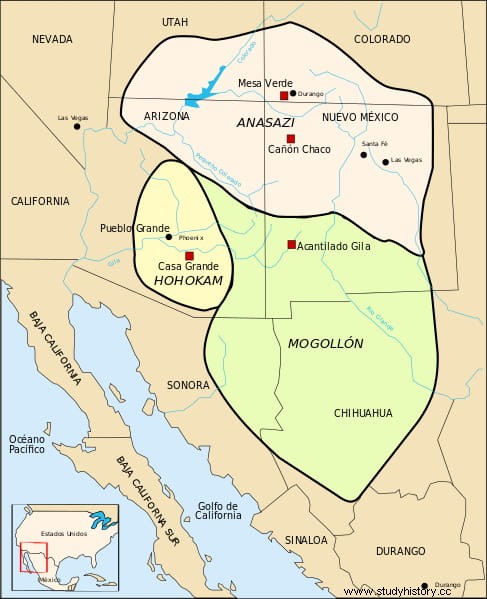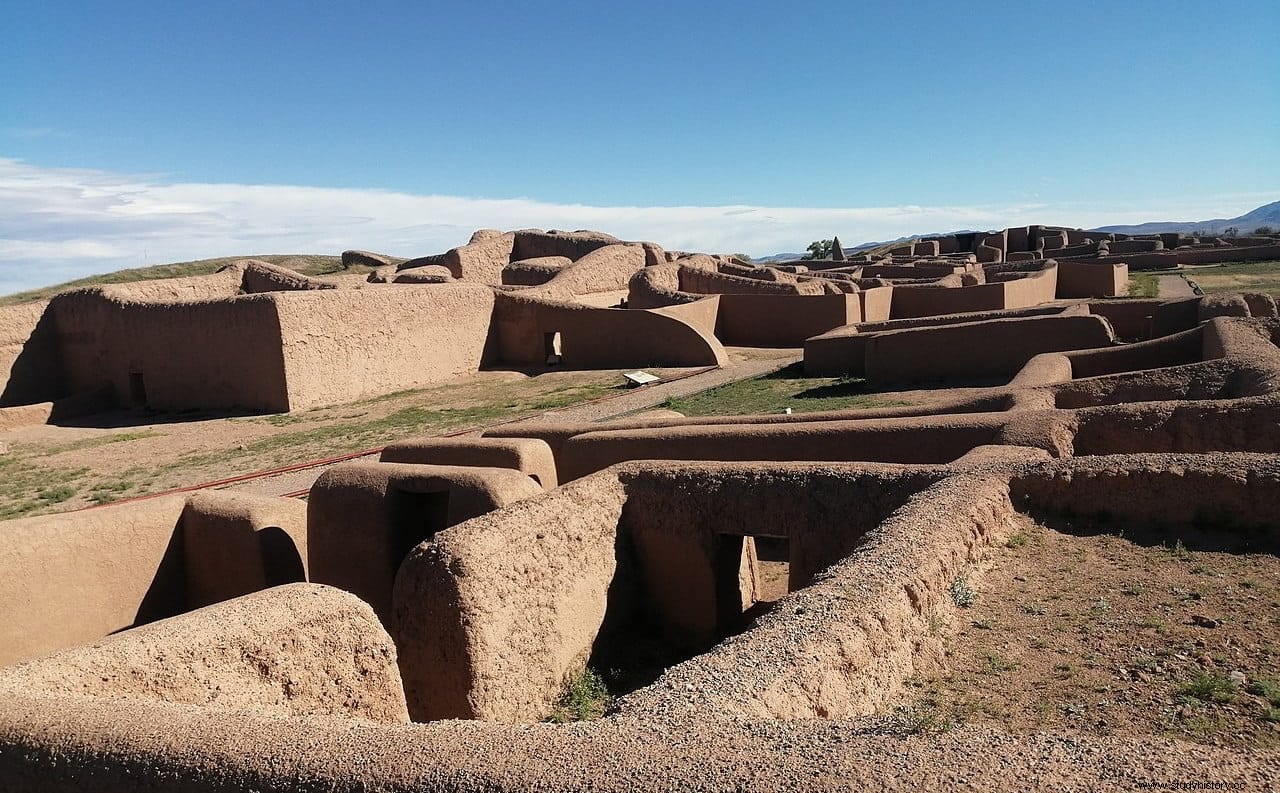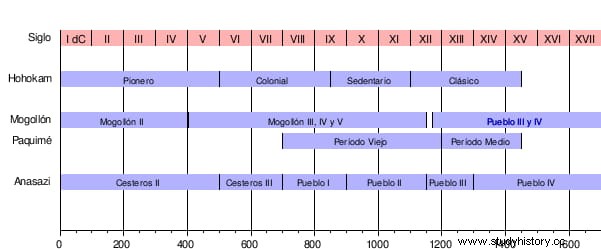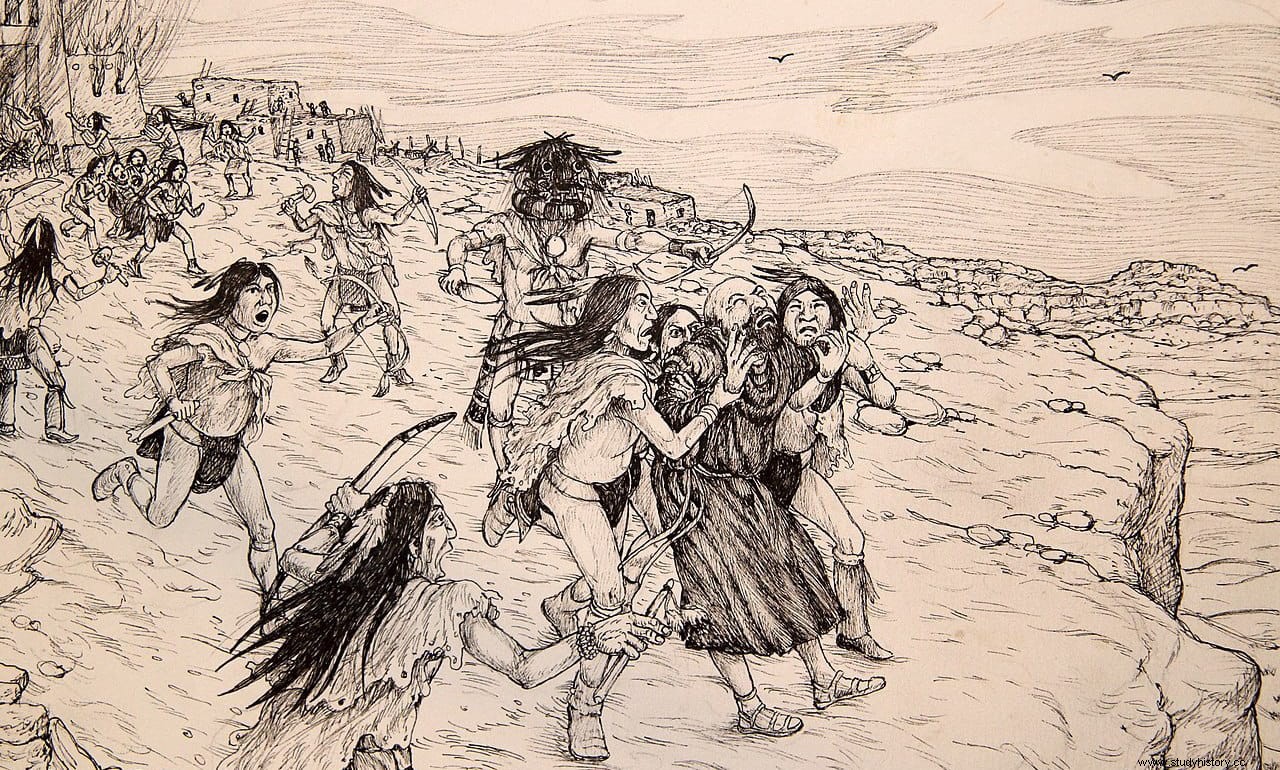1695 was not a year that stood out especially for any historical episode, beyond the eternal war events and the typical birth and obituary anniversaries... unless one was a native of Oasisamerica, in which case one would expect the end of the world to occur. The latter is nothing extraordinary either, since setting an end date for global existence is something that occurs in many cultures. What we want to highlight here is the geographical aspect, since most readers will never have heard of Oasisamérica.
In fact, it is a fairly recent term, appearing in 1954 in an article in the journal American Anthropologist under the title Gatherers and farmers in the Greater Southwest:a problem in classification . It was written by Paul Kirchhoff, a German philosopher, ethnologist and anthropologist who spent most of his professional life researching in Mexico and who already in 1943 had coined another fundamental word for his field of study:Mesoamerica, with which a cross-border geographic area is defined from Mexico, Guatemala, El Salvador, Belize, Honduras, Nicaragua and Costa Rica, characterized by common cultural elements. Eleven years later, Kirchhoff expanded that conceptual terminology by adding two other cultural areas:Aridoamérica, which encompasses the Mexican territory and the western part of Central America, and the aforementioned Oasisamérica.
Oasis America, more commonly referred to by American archaeologists as the Greater Southwest (Great Southwest), would be a region located in North America, one that would extend from the Rocky Mountains to the Sierra Madre Occidental, between the Gulf of California to the west and the Rio Grande Valley to the east. Thus, it is in the southern-eastern territory of the current US (states of Arizona, Utah, New Mexico, Colorado, Nevada and California) and northern Mexico (states of Chichuahua, Sonora and Baja California).

It is a region characterized by its wide and dry plains -which would include part of Aridoamérica-, watered however by rivers such as the Yaqui, the Colorado, the Casas Grandes, the Gila or the Mayo (apart from some lakes that have already disappeared, hence the oasis), which, together with a less harsh climate, favored the development of agriculture and, therefore, the settlement of some indigenous cultures. Consequently, these cultures had a sedentary character compared to the arid American nomads, although the crops were insufficient by themselves to guarantee their subsistence and they had to complement them with hunting, fishing and gathering.
Agricultural techniques were imported from Mesoamerica, with which they maintained commercial contacts due to the abundance of turquoise, a mineral highly valued by Mesoamerican cultures for sumptuary use. This would be demonstrated by the discovery in Paquimé (an archaeological area of Casas Grandes, Chihuahua, with adobe constructions and developed between the 8th and 15th centuries AD) of skeletons of macaws, tropical birds from the jungles of the Yucatan, as well as ceremonial structures that are related to Mesoamerican religions (ball game courts).
However, the historical chronology of Oasisamerica begins a couple of millennia after the separation of Mesoamerica and Aridoamerica. This seems to be demonstrated by the dating of the maize remains found in both places, since the oldest Mesoamericans date back to 5000 BC. while the American oases found in Bat Cave (Arizona) date back to around 3500 B.C. According to this, and contrary to the theories of endogenous genesis, the practice of agriculture would have been imported from the south, although the process is unknown; Some researchers believe that the attribution would correspond to Yuto-Nahua groups.

Now, when did humans begin to inhabit Oasisamérica? It is believed that the first groups of Paleoindians settled there about ten or twelve thousand years ago, although the first material evidence corresponds to a period between 10,500 and 7,500 BC. They arrived attracted by the abundance of water (back then the landscape was less desert), fishing aside. Hunting pressure and climate change forced those primitive settlers to diversify their way of life, adding harvesting, from which they obtained a type of flour, judging by the grinding stones found.
The Archaic period, which extends from 7,000 to 1,500 B.C. more or less, it was that of the introduction of agriculture (corn, beans, pumpkins) and the definitive sedentarization (especially in caves and rocky outcrops, although there were some villages in the plains), especially when the climate began to get warmer. end around 3500 B.C. In that first phase, the typical culture was the call of the Cesteros; It was followed by those of Arena-Dieguito Pinto (6500 BC-200 AD), Oshara (5500 BC-600 AD), Cochise (5000 BC-200 AD) and Chihuahua (6000 BC-250 AD), overlapping each other.
The peak stage of Oasisamérica was later structured into three basic divisions:those of the Anasazi, Hohokam and Mogollón. The first, the northernmost and now renamed Ancestral Pueblos, flourished in the Four Corners region (named for being where the states of Utah, Arizona, Colorado and New Mexico meet), an area abundant in junipers where the ancients lived. ancestors of the current Pueblo Indians (Zuni, Hopi, Tiwas, Navajo). The chronology ranges from the 1st century B.C. until the Spanish conquest in the mid-16th century, following the scheme explained above.

Their distinctive pottery and house building styles emerged in the area around 750 AD. C., although the roots of the characteristics of its material culture can be traced back to the Cesteros II period (1500 BC-400 AD). The most representative thing is its architecture, with masonry houses that had up to five floors - some of which were built on stone cliffs for defensive reasons - and irrigation systems. Of all this there are archaeological remains such as those of Mesa Verde, Pueblo Bonito, Chaco Canyon, Aztec Ruins and Salmon Ruins.
A persistent drought in the last quarter of the 13th century and the overexploitation of the environment caused its decline, aggravated by the fact that they were not united because they were ethnically different from each other (the Hopi spoke an Uto-Aztecan language, while that of the Navajos was Athabascan). and the Zuni lacked parental relationships with the rest). This weakened them in the face of Hispanic domination, despite the fact that, by maintaining cultural similarities with their Hohokam neighbors (from whom they distinguished themselves in that they did not bury their dead but cremated them) and Mogollón (who were more like hunters), they must have reached a considerable number.

The Hohokam lived in what the Spanish called Pimería Alta, a region south of the Sonoran Desert, between the Gila and Colorado rivers. A difficult habitat, with little rainfall and high temperatures that forced them to build a vast irrigation system that channeled these riverbeds, thanks to which they could practice agriculture and obtain two annual harvests. It is not known whether their culture was autochthonous or the result of emigration from more southern lands, but it emerged between the 3rd and 4th centuries BC. and maintained trade relations with Mesoamerica.
Their settlements were smaller, with semi-underground dwellings to escape the heat. But, as happened with the Anasazi, when the Spanish arrived the Hohokam had already been in deep decline for some time for the same reasons as the former, so villages like Snaketown, Casa Grande, Red Mountain or Pueblo de los Muertos were only a shadow of a shadow. what had been, for example, the Salado culture. The Pimas and Papagos are current heirs to the Hohokam.
The southernmost area of Oasisamerica was the Mogollón, located between Arizona and New Mexico. Its history is somewhat confusing from the chronological point of view, as it is usually divided into two main stages, an Early one (500 BC-1000 AD) and a Late one (until approximately 1540 AD). It was in the second when it reached its splendor, thanks to trade with Mesoamerica and the Anasazi influence, from which they imitated their architecture, although this apogee was fundamentally focused on the Paquimé culture -which some consider separate-, with a center in the Sierra Madre Occidental. and Casa Grande as the most prominent population center.

The rest of the mogollón would have begun to decline earlier, around the 13th century, migrating and merging with the Anasazi and others with the Chichimecas of Coahuila. Their memory is preserved in the archaeological ruins of the Gila Wilderness, Mimbres River Valley and Hueco Tanks -with special mention for the colorful pottery they made because it was decorated with figurative motifs, instead of the usual geometric ones-, as well as in their Taracahita descendants ( ópatas, mayos, yaquis and tarahumaras).
To these three great cultures we must add three less developed ones. It is made up of Fremont, Utah, and parts of Nevada, Idaho and Colorado, which some consider to be part of the Anasazi and others derived from the Athabascan buffalo hunters, although it joined the former, leaving its place to the Shoshones; the peripheral Pataya, which lived between Arizona and California (USA), Baja California and Sonora (Mexico) and influenced by the Hohokam; and the Trenches of northwestern Sonora, which was influenced by the Mogollón (some consider it part of it) and the Hohokam.

As we can see, the Oasis American peoples had already declined long before the arrival of the first Spaniards. Perhaps that terminal phase led them to configure the belief that their world would end on a date that, in the Gregorian calendar, coincided with the year 1695. A curious coincidence, since it was then, on April 2, when a great revolt against the rule of the crown of Carlos II in Arizona, which was part of the Viceroyalty of New Spain. But it didn't come out of nowhere. The Pueblo Indians had already risen up in 1540, in the so-called Tiguex War, forcing the departure of the Spanish. They returned and prevailed in 1599, returning to a certain calm that was broken again in 1680, with the revolt of the sorcerer Popé, who again expelled them.
The reconquest could not be carried out successfully until the campaign of Diego de Vargas in 1692, but the peace was fragile and tense due to the curtailment of the autonomy that existed until then. It was aggravated by the fact that the Spanish appropriated more and more indigenous lands to satisfy the increase in the influx of settlers, attracted by the growing mining and ranching activity; something that, obviously, required a closer control of the region to the detriment of the treaties signed between both parties. The first to rise up were the Seri, an isolated ethnic group that inhabited the coast of the Gulf of California and had always been combatively hostile to evangelization and sedentarization, which is why its members often ended up enslaved as prisoners of war.

Later, other Pueblo tribes joined in, plunging the region into a state of open warfare in 1696. The repression on this occasion was harsh and many of those people had to seek refuge among other groups, such as the Apaches or the Navajos. Thus, pacification was achieved to enter the new century with some calm. The viceregal administration changed its policy, initiating one of rapprochement and legal defense of the Indians in court through a public representative. Likewise, forced evangelization, considered the cause of the uprisings, was renounced (dances and ritual objects were prohibited, hence the missionaries were often the first to die), which allowed the people to preserve their traditional beliefs.
However, the Pimería insurrection, as it was said then, would not reach truly serious dimensions until 1751, with the so-called Pima Revolt or O'odham Uprising. Under the leadership of the former collaborating cacique Luis Oacpicagigua (or Luis de Sáric, alluding to the province of the same name), who had been an Indian governor but whose charisma managed to unite all the groups totaling fifteen thousand men, it developed over several months and cost a hundreds of lives of settlers until Captain José Díaz del Carpio managed to negotiate peace in the spring of 1752.
Initially there was no retaliation because the Indians obtained a pardon from the governor by blaming everything on the Jesuit missionaries, an order that was already in a bad relationship with the Crown (shortly after its members would be expelled from Spain and its overseas territories). Thanks to this, the viceregal administration changed its policy. However, the conflicts would be reproduced on a smaller scale and this would force an increase in the network of prisons (fortines) in San Ignacio de Tubac (Arizona), Santa Gertrudis de Altar (Sonora), and San Carlos de Buenavista (Sonora), prolonging the tension until the end of the century. Then, everything would catch fire again, already in independent Mexico.
